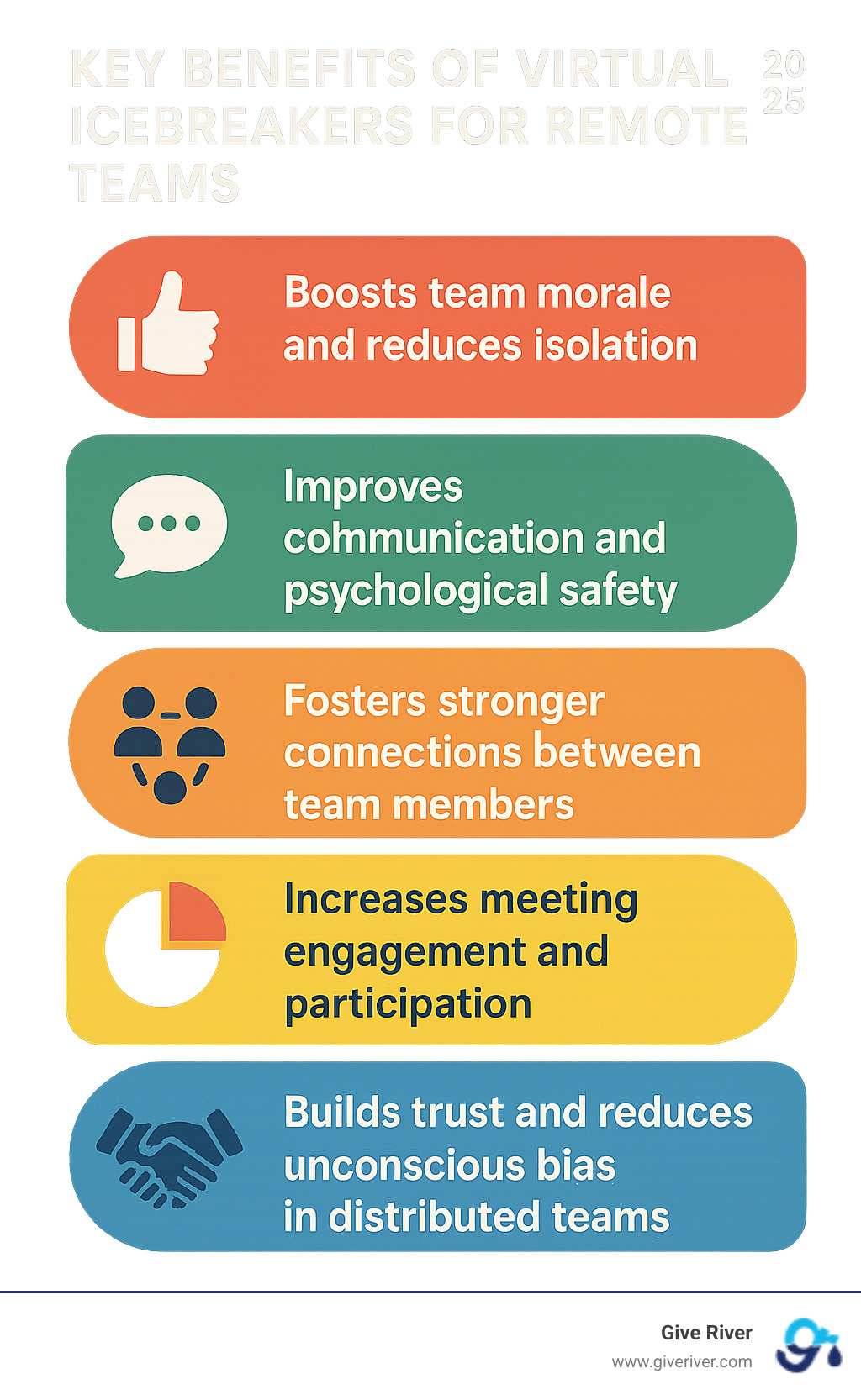Warm Up Your WFH Meetings: Engaging Icebreaker Games
Boost team morale & connection! Discover engaging remote working icebreaker games to warm up your WFH meetings.

Beyond the Awkward Silence
Remote working icebreaker games are essential for how distributed teams connect in virtual meetings. Instead of jumping straight to business, these activities break down barriers, spark conversation, and create the psychological safety that remote teams need to thrive.
Top Remote Working Icebreaker Games:
- Quick Questions: Would You Rather, Two Truths and a Lie, Desert Island Picks
- Interactive Activities: Virtual Scavenger Hunt, Digital Show & Tell, Guess Whose Desk
- Competitive Games: Remote Work Bingo, Virtual Pictionary, Company Trivia
We've all been there—the start of a virtual meeting filled with awkward silence. Research shows that remote workers can become detached without consistent effort, leading to decreased collaboration. In fact, 27% of employees don't make it beyond their first year if they feel disconnected from their teams.
Without the natural water cooler conversations of physical offices, remote workers often become siloed. But virtual icebreakers are more than just nice-to-have activities. They are strategic tools that foster psychological safety, helping teams build the connections that drive better outcomes.
I'm Meghan Calhoun, and with two decades of experience in high-pressure environments, I've learned that meaningful connection is the foundation of every successful team. At Give River, we've seen how the right remote working icebreaker games can transform virtual meetings from awkward obligations into energizing experiences that strengthen team bonds.

Remote working icebreaker games terminology:
The Ultimate List of Remote Working Icebreaker Games & Activities
Ready to turn quiet virtual meetings into hubs of connection? Remote working icebreaker games are your secret weapon. They lighten the mood, spark real conversations, and get everyone engaged. When your team feels connected, they build stronger bonds and achieve better results. Let's explore some of our favorite activities, grouped by the type of interaction they create.
Quick Icebreaker Questions to Spark Conversation
These quick icebreakers are fantastic for warming up any meeting without much time or prep. For extra fun, use your meeting software's poll feature for quick responses!
- Would You Rather: This timeless game is a brilliant way to peek into your teammates' minds. Just throw out two fun, hypothetical choices—like "Would you rather have four hands or four legs?"—and let the discussions begin.
- Two Truths and a Lie: Each person shares three statements about themselves: two true, one false. The team plays detective to guess the lie. It’s a fantastic way for new teams to build rapport and uncover surprising facts.
- Desert Island Picks: Imagine you’re stranded on a desert island. What three items would you bring from a specific list? This game reveals how your team thinks under pressure and what they prioritize.
- One-Word Check-in: For a quick pulse check, ask everyone to sum up their current mood or week in a single word. Using a word cloud tool can make this visually engaging.
- Bucket List: Ask team members to share one item from their Bucket List. This simple question can reveal surprising common ground and a glimpse into your colleagues' aspirations.
For more ideas, dive into our guide on Fun Ice Breaker Questions for Virtual Meetings. You'll also find valuable prompts in our collection of Team Building Questions for Remote Workers.
Engaging Icebreaker Activities for Team Interaction
These activities encourage more interaction and are perfect for established teams looking to deepen their bonds.

- Background Challenge: Ask your team to pick a virtual background that fits a theme, like "your favorite movie set" or "a dream travel destination." It’s a hilarious way to inject personality and spark conversation.
- Digital Show & Tell: Each team member grabs an item from their home or shares something from their digital world and tells its story. Hearing the tales behind everyday objects can build genuine personal connections.
- Guess Whose Desk: Team members secretly submit photos of their workspaces. The facilitator shares them, and everyone guesses who each desk belongs to. It’s a playful way to make remote work feel less distant.
- Virtual Scavenger Hunt: Get everyone moving! Give participants a list of common household items and a time limit to find them. This activity is a fantastic energy booster that often leads to hilarious reveals.
- Team Timeline: Each person adds a significant personal or professional milestone to a shared digital whiteboard. The result is a collective timeline of your team’s journey, fostering empathy and a sense of shared history.
Explore more ways to get interactive with our resources on Remote Work Culture Activities and Fun Activities for Online Meetings.
Fun Virtual Icebreaker Games for Friendly Competition
A little friendly rivalry can spark morale and engagement. These games are about lighthearted competition designed to get everyone laughing and collaborating.

- Remote Work Bingo: Create Bingo cards with squares like "Has a pet" or "Drank coffee today." Players mark off squares as they find commonalities with colleagues. The first to shout "Bingo!" wins. It's a brilliant way to find common ground.
- Virtual Pictionary: This classic party game translates perfectly online. One person draws on a virtual whiteboard while others guess the word. It’s a fun way to encourage creative communication.
- Company Trivia: Test your team's knowledge with questions about your organization's history, milestones, or inside jokes. This game reinforces shared knowledge and a sense of collective identity.
- Emoji Charades: Team members communicate movie titles or phrases using only emojis. Participants send their emoji sequences in the chat, and others race to guess the meaning. It's a unique way to boost creativity.
For more competitive fun, check out our lists of Best Free Virtual Games and Virtual Team Challenge Games.
How to Run Icebreakers That Actually Work
Let's be honest: the phrase "icebreaker games" can sometimes make people groan. But when done right, remote working icebreaker games are powerful tools that build the foundation for psychological safety, helping teams feel more connected. A poorly executed icebreaker, however, can create the very awkwardness we dread. Here’s how to get it right.
Choosing the Right Icebreaker for Your Team
The success of an icebreaker depends on how well it fits your team and your goals. First, think about your meeting objectives. Are you warming everyone up, introducing new members, or prepping for a brainstorm? The activity should align with your purpose.
Next, consider your team size. For large groups, quick questions in the chat or activities in breakout rooms work well. Smaller teams have the flexibility for more in-depth games that build deeper connections.
Also, consider group dynamics. For new teams, start with low-stakes games like "Two Truths and a Lie." As trust grows, you can introduce more personal activities. Finally, be mindful of time constraints. Icebreakers should last 5 to 15 minutes—enough to engage everyone without derailing your agenda.
The goal is to pick activities that are inclusive, engaging, and relevant. For more ideas on structuring your team activities, check out our guides on Team Building Activities Ideas and Hybrid Work Team Building.
Best Practices for Facilitating Remote Working Icebreaker Games
Effective facilitation is where the magic happens. It's about creating a safe space where everyone feels comfortable participating.
Psychological safety is paramount. Remote working icebreaker games foster this by creating an atmosphere where colleagues can speak up without fear of judgment. When people feel safe, they engage more, leading to stronger connections. As organizational psychologist Dr. Mahreen Khan points out, strong team cohesion is key for success in distributed teams.
Always provide clear instructions. Explain the purpose, rules, and timing to reduce anxiety. Lead by example with facilitator participation. Your enthusiasm is contagious and encourages others to join in.

It's also important to avoid pitfalls. Stick to your allocated time. Recognize that not everyone will enjoy every activity, so ensure participation is encouraged but not forced, especially for introverts. Most importantly, avoid questions that could make people uncomfortable.
For larger groups, leverage breakout rooms to allow for smaller, more intimate discussions. Finally, integrate with purpose. Connect the icebreaker to the meeting's theme or a broader team goal to reinforce its value.
While recognition-focused platforms such as Bonusly or Kudos primarily offer standalone reward systems, Give River’s holistic approach uniquely combines connection-building activities like these remote working icebreaker games with our comprehensive 5G Method. This method boosts employee fulfillment and productivity through recognition, guidance, wellness, growth, and community impact, fostering true team cohesion.

Understanding Organizational Culture in Virtual Teams is key, and we encourage you to explore Scientific research on psychological safety to grasp the profound impact of these simple activities.
Conclusion: From Icebreakers to a Stronger Team Culture
In our remote working world, we miss the spontaneous "water cooler" moments that build bonds. Without them, employees can feel disconnected, which chips away at team spirit. The good news is that remote working icebreaker games are a powerful solution.
These aren't just fillers; they are strategic tools that transform the team experience. They boost morale, improve communication, and increase engagement by making meetings more interactive. Crucially, icebreakers are foundational for fostering psychological safety. When people feel safe to speak up and share ideas, true collaboration blossoms.
Virtual icebreakers break down the invisible walls between remote team members. They are a delightful way to unite your team, lift spirits, and weave a healthy communication network. A team that enjoys spending time together will naturally trust one another, profoundly improving how they work together.
At Give River, we believe employee fulfillment goes beyond simple engagement metrics. It’s about creating a workplace where every team member feels valued, connected, and empowered. Our holistic 5G Method—focusing on recognition, guidance, wellness, growth, and community impact—is designed to nurture that sense of belonging. The thoughtful use of remote working icebreaker games fits perfectly within our approach, fueling authentic connection.
By consistently using these games, you're making a long-term investment in the health, cohesion, and productivity of your remote team.
Ready to cultivate a vibrant, connected remote team? Dive into our solutions for Virtual Community Building and Learn how to build a stronger team culture with Give River.




